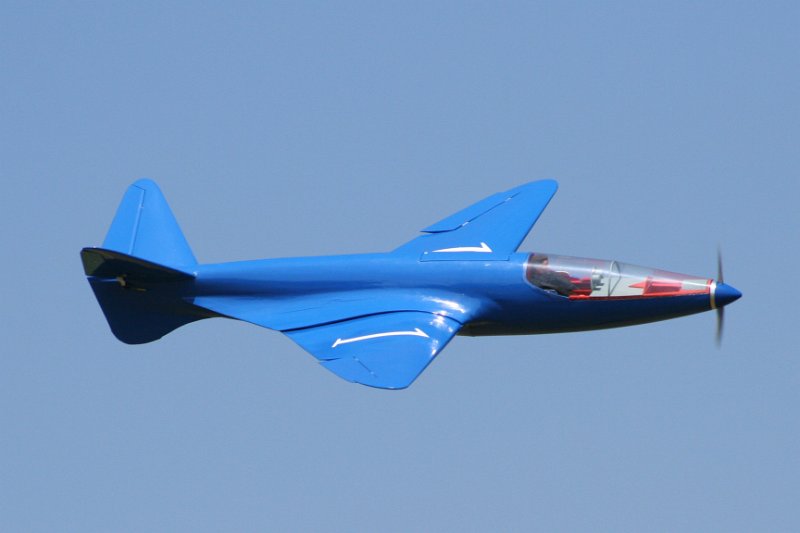
The origin of this research is due to a problem of noise pollution for the vicinity of our airplane field. Anxious to preserve our site and the tranquility of local residents, we have defined a certain number of actions.
Immediate actions: Reduce the inconvenience caused.
- Proportional use of the throttle:
The elders have sensitized the most novice to the interest provided by the use of the 4th axis. This involves flight demonstrations highlighting the realism of mid-gas powered flight. - Redefinition of the flight envelope for not approaching the houses.
- Awareness of noise by systematic measurements of the sound level of all aircraft at 3 speeds (idle, gas and full throttle).
- Display of the result of the measurments to raise awareness of the noisiest pilots.
Short-term actions: To significantly reduce the noise from the exhaust of heat engines.
- The first phase consists of looking for ready-made solutions from dealers to reduce exhaust noise. These searches were, unfortunately, unsuccessful (except resonators at prices incompatible with early planes or trainers). In addition, our usual suppliers do not seem to be concerned about this problem and almost always refer us to electric propulsion.
- We then “peeled” our entire stock of magazines. There, the fishing is better. Several articles have been written and essays by model makers have been published.
A big thank you to Pierre Rousselot for these articles which appeared in the MRA magazine from April to July 1981 and then in February 1990 which gave us the basic ideas which were used for our own investigations. The principles set out by P. Rousselot are repeated below.
The production of prototypes:
The principle adopted is based on that used in our cars. Namely, a first expansion chamber responsible for cooling the gases, then a second responsible for absorbing the high frequencies. The idea is therefore to use the original silencer as the first chamber and add a second for absorption.
We therefore undertook the production of several silencers with various and varied means.
Three easy-to-implement solutions emerged.
- The first is from the metal cake box cut and welded or based on pressurized bombs (empty),
- The second is a recycled aluminum bicycle pump
- And the third is based on PVC tube


The principles:
The principles used are described in the diagrams below:

The use of either scheme showed no significant difference.
The rules we used are as follows:
- Volumes = between 10 and 30 times the engine displacement
- Internal tube diameter = diameter of the silencer outlet
- Total hole area = 1.5 times the output of the silencer.
The measures and the first results:
The measurements were made with the three prototype mufflers and the results were taken at 3 speeds (idle, half-throttle and full throttle) in order to measure the influence of the muffler according to the use made of the engine.
The reference plane is equipped with an OS 40 FP engine and a 10.5 x 6 Graupner propeller. The measurements are made, on grass, 3 meters from the plane perpendicular to its flight axis and 30 cm from the ground.
The results of the measurements are given in the following graph:

The measures conclusions:
It appears, as was to be expected, that engine performance is affected by a bad geometry of the muffler. This results in difficulties in adjusting the engine and a significant loss of revolutions at full throttle. In this case, the operation of the engine is not reliable and generally does not last. The sheet metal pot is an example, and if the noise level is low, this is due to the lower engine speed than in other cases.
A muffler adapted to the engine only slightly degrades its performance. We therefore note:
- A loss of speed of 200 to 400 revolutions / minute.
- The best sound gain is therefore 6dB.
This corresponds to a reduction by 4 of the sound power.
This figure was confirmed by systematic measurements made on other planes with different engines and propellers.
The generalization of silencers:
The principle being established, it was communicated to all the members of the Club so that everyone can equip themselves.
However, this achievement is not always within everyone’s reach (beginners, the youngest and followers of the “Ready to fly”), a number of silencers had to be made in order to be able to offer them.
In order to go quickly and get a very low cost, we chose to make the PVC tube and close it with a glass cloth coated with resin. The internal tube is an Alu tube of 8 or 10 depending on the displacement (25 or 40). This tube is pierced with twenty or so 2 mm holes and pinched in the center. The principle is effective and two evenings (with several) allowed the production of a dozen pieces. The cost price is around 10 Euros per unit and the weight of a hundred grams.
Today, the maximum noise authorized on our site is 89dB (instead of the 92 regulatory). Each aircraft must undergo a measurement before being authorized to fly.
We see that this constraint is fully accepted and the results encouraging. Indeed, some planes, particularly silent, are now at 82dB. It is a real pleasure to hear them, sorry, not to hear them evolve. In the end, we save the neighborhood and we all benefit.
The following:
The exhaust problem is now better controlled, we see that there is still work. Engine explosions are not the only source of noise. We notice, on the quieter planes that the noises of the propellers become predominant without speaking about the vibrations of the structure of the plane.
So we are now embarking on a new area of research.
